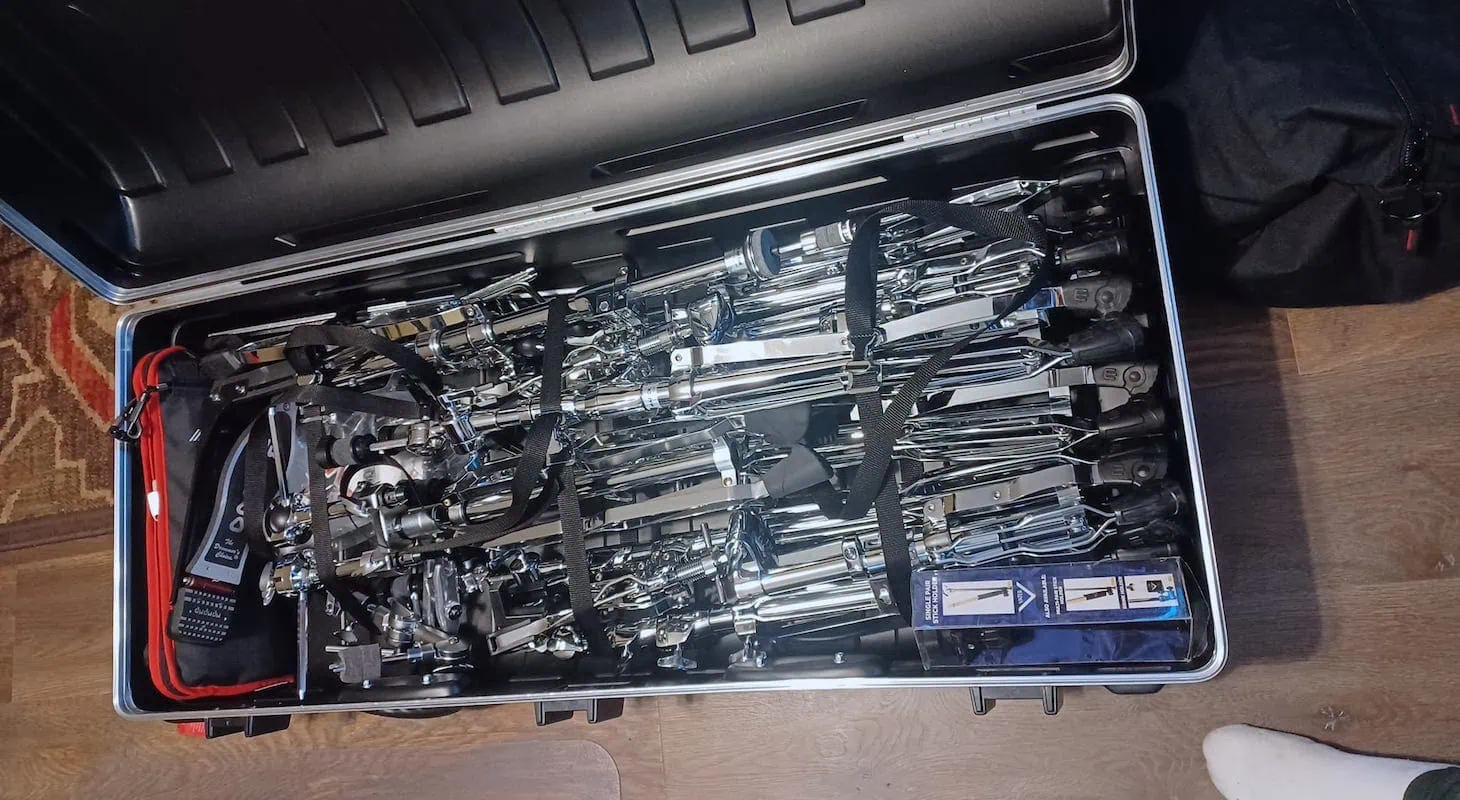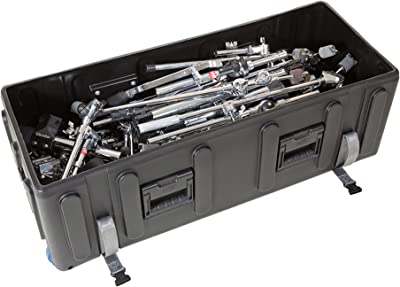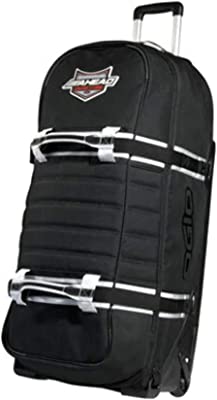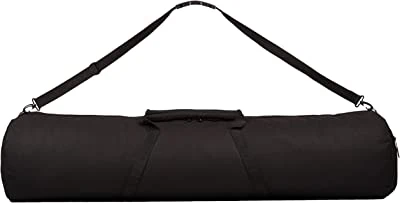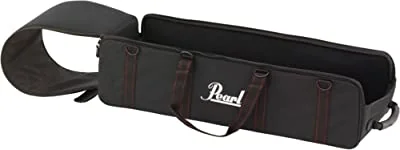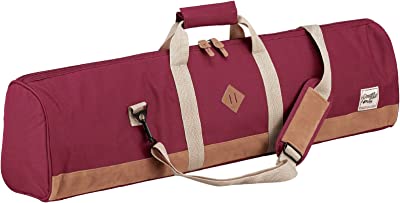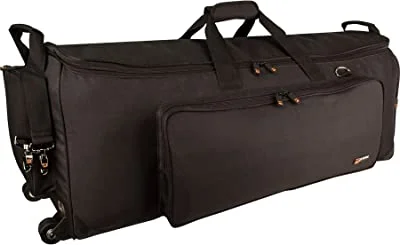Drummers, while we do love our instrument, admittedly the components required to play are not the easiest things to carry around from gig to gig. The tom and cymbal stands are heavy and at times a little awkward to carry.
If you are planning weekend gigging or are prepping for a lengthy tour, then a hardware bag or case is an absolute must-have.
Top 3 - Drum Hardware Bags & Cases
We will look at some of the most popular choices for hardware bags and cases frequently used by gigging drummers.
Best Drum Hardware Cases & Bags for Easy Travel
1. SKB 1SKB-DH4216W Rolling Drum Hardware Case
This hardware case looks well-built, sturdy, and rugged. This SKB Rolling Case is 42” x 16” x 16.5”. That 16.5” of depth and 16” of width makes for easy storage of nearly any hardware.
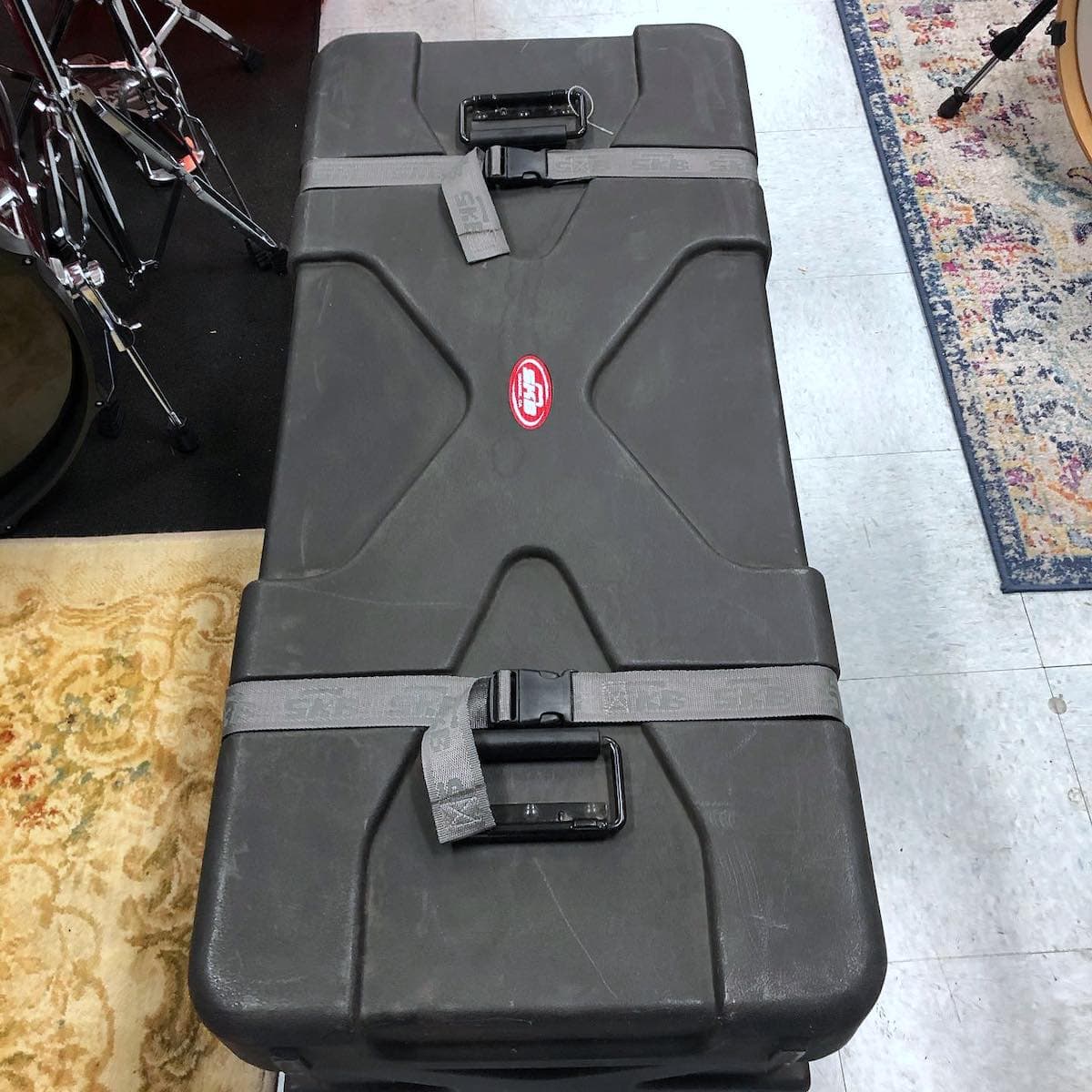
SKB Rolling Drum Hardware Case
This case just feels and appears very strong. It feels like you can throw it around a bit without a problem. Not that I recommend doing that. When transporting your expensive gear in a car or maybe on a plane, I’d feel confident that this would protect my hardware inside.
SKB placed two handles on each side of this case as well as a single handle on each of the shortest sides. A very smart choice here! The placement of these handles will allow you and one of your bandmates to easily carry this case up or down a flight of stairs or hoist it onto a stage.
SKB has also thoughtfully added a collapsible tow handle. The combination of the tow handle and wheels built into the case makes for easy stress-free transport.
I do wish that there was something within the case to better secure your hardware. All hardware within the case is loose which has the potential to cause issues should the case be jostled around a lot.
In case you’re worried about the possibility of the topping popping off, never fear! SKB has added two, adjustable, thick nylon straps on both ends. The straps easily clip atop the case and once clipped they can be tightened down for maximum security.
SKB wisely added wheels to this case because, given its rectangular size, it becomes difficult to slide even on slick floors once packed with hardware. The sturdy wheels are especially useful when I'm rushing — whether getting off stage or through an airport. I've even managed to transport two cases simultaneously thanks to how well the wheels work.
One drawback of these drum cases is that they're essentially just plastic drawers with wheels and straps. Regular loading and unloading can leave your gear pretty scratched up.
I'm meticulous about my drums and like to keep everything shiny and in great shape — even the stands. Since these cases aren't padded, they can get quite noisy when not fully packed. Your stands can rattle around inside, especially when moving through public spaces.
Here's my solution for protecting your stands and reducing noise: I use exercise waistbands made of stretchy material with Velcro to bundle groups of hardware together. This not only prevents them from colliding but also creates interior padding thanks to the spandex material.
You can find these bands cheaply at most household retailers, and they make transportation much smoother. Without hardware banging against the lid, even rolling becomes quieter.
Interestingly, SKB cases have an unexpected musical benefit — they make excellent percussion instruments. It might sound strange, but many drummers, myself included, have actually recorded using empty drum cases as drums.
When played with mallets and closely miked, they produce a dull, dead tom-like sound that can even pass for a Taiko-style drum.
This technique is so well-known that the BFD Drums Oak Custom sample collection includes a sampled drum case as a snare replacement option. So I'm clearly not alone in this discovery!
For all you experimental artists out there, it's a clever trick that makes hauling your heavy drum gear serve double duty — both as protection and as an instrument.
2. Ahead Armor Cases Drum Sled Rolling Hardware Case
Ahead is probably known best for the drumsticks made famous by Lars Ulrich of Metallica. The innovators at Ahead have teamed up with the award-winning, Ogio-engineering to create this handy item they call a Drum Sled.
This Ahead Armor Case measures 38" x 16" x 14". In addition to its respectable interior size, it also has pockets inside for easy storage of drumsticks and any additional items you might need.
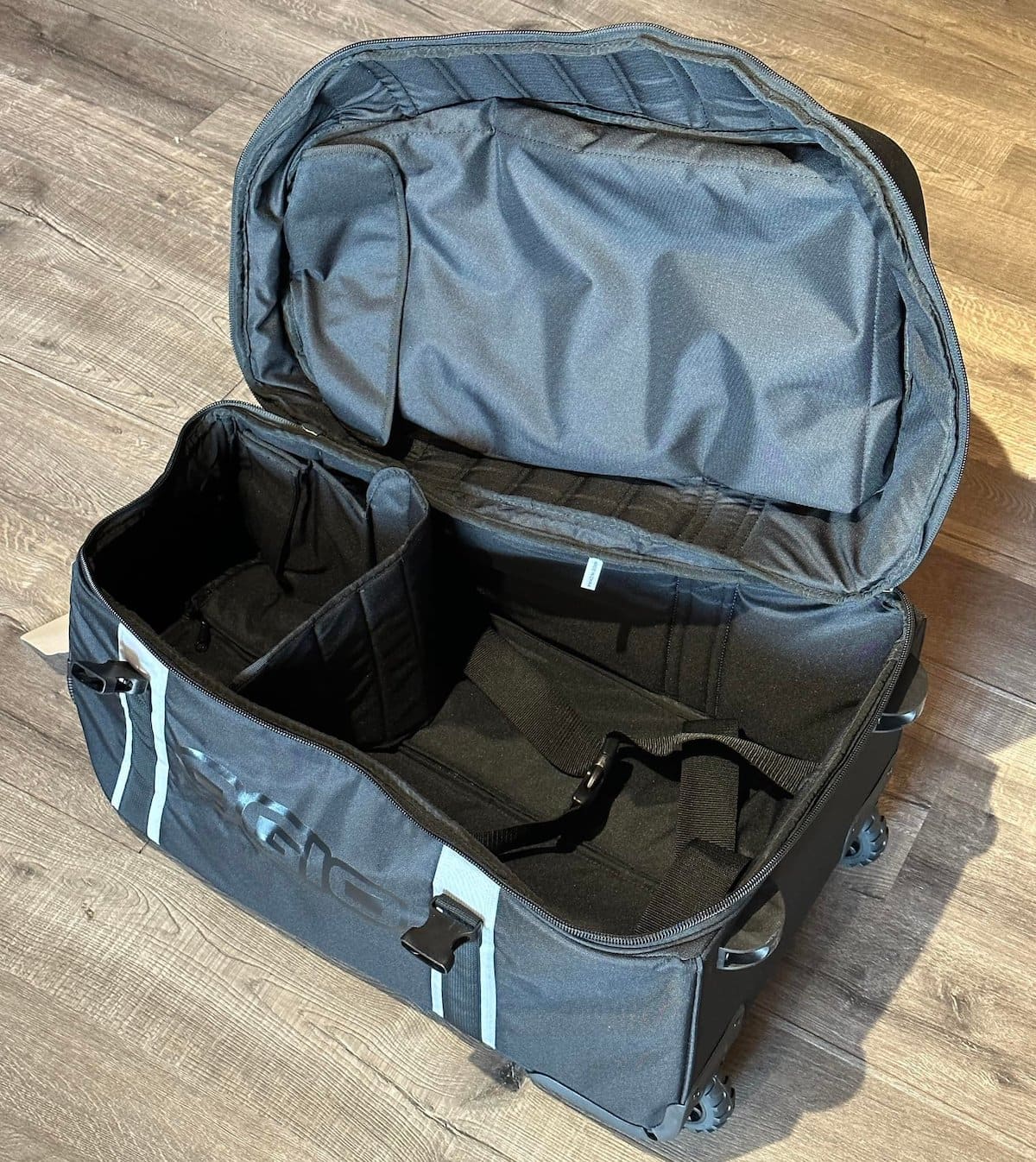
Ahead Armor Drum Sled Rolling Hardware Case
The zippers are oversized for easy grip and rip. Within the bag, you will find nylon straps to secure your stands, pedals, and other items. There are also some separator components in case you want to compartmentalize your items.
This Ahead hardware case is made from a strong, weather-resistant material called 600D polyester. While I was not able to test it for myself, Ahead claims this is a weather-resistant bag that can withstand rain, sleet, or snow.
The bag's underside is lined with a 38” plastic roller board that very much resembles the underside of a sled.
The handles on the outside are wide enough for easy gripping without hurting your hands. They are also easy to locate since they are outlined in gray color.
A retractable handle and oversized wheels with smooth bearings make this an easy bag to tow around.
The only real issue here is if you’re expecting the bag to be able to stand on its own, it can’t when loaded up. You will have to lay it down or it’ll keep toppling over on its face.
This type of case works well for transporting equipment between local venues — rehearsal spots, shows, and recording sessions — anywhere you can drive to. However, I encountered issues when traveling internationally by plane.
The main problem is that the fabric construction means the case has no straight edges, making it impossible to stack anything on top. This becomes a serious limitation when checking in luggage or loading equipment on and off buses.
Traditional stackable cases are more practical since you can stack them vertically for easy loading and unloading. With this case, anything placed on top simply slides off because there are no flat surfaces except the bottom sled.
I also wish they had considered making the manual straps convertible to backpack straps. While I understand the case becomes too heavy when fully loaded to use as a backpack safely,
I often use it for lighter items like accessories rather than symbol stands or high hat stands, making it suitable for back carrying. Even a shoulder strap would have been a welcome addition.
The minimal interior padding does help reduce noise from stands clattering against each other and the lid. This has always been one of the most frustrating aspects of hard cases — they can become extremely noisy in tour vans or during transport unless properly insulated.
Another concern is that the fabric tends to crease when not fully packed. Though the case is water-resistant, moisture could potentially dwell in these creases, without fully drying. Even if water never reaches your gear, it can collect on the surface during transport, creating a mess.
Unlike hard cases where you can simply wipe away water with a towel, dealing with moisture on this duffel bag-style case is much more complicated.
3. Gator GP-HDWE-1350 Drum Hardware Bag
Gator’s GP-HDWE-1350 Drum Hardware bag measures 13” x 50”. It is made from an extremely durable 600 Denier Nylon and lined with a synthetic fur interior for a nice soft touch.
Like other Gator products, it’s a well-made, sturdy bag that can easily fit your hardware.
Depending on the size or bulkiness of the cymbal stands you use you should be able to fit about 3 to 4 in this bag without issue. You’ll have room for your floor tom legs or any other smaller items as well.
On the top end (or bottom depending on how you orient the bag) there is a compartment for your felts, hi-hat clutch, gels, or other accessories you may utilize while gigging. Other than small items and your cymbal stands, and snare stand, not much else can fit in here. It’s limited because of its size.
In addition to the handles you can grab from the middle, Gator also provides you with an adjustable shoulder strap for easy carrying. The strap disconnects/connects easily via a carabiner-like connector.
I would recommend not overloading this bag with too much weight. While the strap and handles do feel well made, putting any unneeded stress on them often will eventually cause stress breaks in the stitching or bag liner. This would be the case for any bag, not this one in particular.
The cylindrical shape of this bag creates poor weight distribution. With more than two stands, it becomes heavy and awkward to move. Its unusual length doesn't fit well on most airport carts, and without wheels, you're forced to place it on top of any wheeled transport.
For those who've played festivals — especially jazz festivals — where stage turnaround time is incredibly quick, a wheeled case is essential if you don't have a roadie to help transport your extra stands before the set.
If you're planning to travel or tour frequently with a nylon case, I strongly recommend choosing a sled case instead of the basic cylindrical nylon bag.
However, I do appreciate the compartment for felts, gels, and clutches. Finding good ways to organize drum cases has always been a challenge, especially when you frequently tune your drums.
I'm one of those drummers who adjusts their snare for almost every set — sometimes even per song — either dampening or brightening it. I've even used homemade accessories on my cymbals to dampen them or on metal pieces to create unique sounds.
For all my cases, I've added zippered compartments to store everything from metronomes and accessories to electrical tape and rubber strips — whatever I need, I have a place for it in the bag.
That has always been my main complaint about SKB cases: while they're very well built on the outside, they're far too plain on the inside. This Gator case has more to offer.
If you’re looking for something to carry just your hardware then this would be a great choice. Its simple easy-to-use design will make transporting your gear all the more convenient.
4. Pearl Lightweight Rolling Hardware Bag
Pearl’s Lightweight Rolling Hardware Bag measures 33.75” (external length) x 12” x 9.25”. At the bottom of the bag, you’ll find two big wheels that very much resemble the kinds of wheels you’d see on a kick-scooter.
This bag has plenty of space for stands, pedals, and more. The nice padding and lining reduce clanging noise and prevents your stands from getting scratched against hard surfaces.
It's also much easier to unload your gear from a bag like this since there are no sharp edges to deal with. You wouldn't believe how many times I've hurt my hands on SKB cases — over time, repeated opening and closing sharpens the edges where the lids meet.
If you need to get your gear up a flight of stairs there are two carry handles attached. You could also utilize a shoulder strap to free up your hands should you need to. This has always been one of my biggest complaints about other fabric bags.
While it's not ideal to carry a fully packed drum bag loaded with stands, sometimes you have no choice.
There are two plastic braces/skid plates on the underside of the bag that keeps it from dragging on the floor. A nice feature in case you may need to slide this around or store the bag on a rougher surface from time to time.
This is very helpful on stage when you're in a hurry to switch drums from the previous band, such as at festivals or when playing with other bands. You have just enough time to unload your equipment before you need to quickly move your gear off to the side.
After spending a little time looking this hardware bag over I did notice some glaring issues with its overall build. Which honestly surprised considering Pearl makes other great products.
First of all, the bottom of the bag is not reinforced at all! All the weight of the hardware is pushing against the fabric. With regular usage, the fabric is inevitably going to wear away, especially when continuously under stress from the weight of the hardware.
The wheels are curiously attached to plastic. Again, under a lot of weight, the plastic is going to flex, become brittle, and break. Parts that need to bear weight should never be made of plastic in my opinion.
Overall, a functional bag with some design flaws.
5. Tama Power Pad Designer Collection Hardware Bag
I have to start by saying that this is a very classy-looking bag!
The Tama Power Pad Hardware Bag measures 34.6” x 7.8” x 5.9” and is made from strong Nylon material.
The Nylon doesn’t have a lot of stretch to it which I liked. To me, that means this bag will hold up over many years and use.
These bags from Tama come in a variety of colors like Wine Red, Navy Blue, Moss Green, Black, and Beige.
A double zipper adorns the top of the bag. Adorned with accent color matching pull tabs that pull the whole thing together. Literally.
Both the shoulder strap and carry handle are cushioned. The shoulder strap is reinforced with metal anchor points as well as a metal clasp.
While the bag is fashionable and a pleasure to look at it does also have ample room for hardware. Tama claims you can fit about 5 cymbal stands. That may be a problem for bulkier makes of the stand.
The underside of the bag has 4 evenly spaced plastic patches to prevent scratching and keep the bag somewhat elevated. A nice touch.
This bag doesn’t have wheels or any other method of transport other than the straps you see. You will be carrying this by hand unless you place it on a trolly or something of that sort.
For drummers who desire a little bit of style and play on a simpler setup kit, this is a great choice.
It's a good travel choice locally, especially for wedding gigs at high-end resorts. The clients appreciate when you elevate your design game, and the band equipment looks impressive when you arrive at the venue.
The shoulder strap is very comfortable, and the distance between it and the handle is well-proportioned. This is crucial because with five stands loaded, it gets so heavy that I need both the shoulder strap across my body and the handle gripped in my strong arm to carry it.
It fits well in most car trunks and backseats — perfect for those of us traveling to local gigs without a van.
The double-zippered pocket is excellent, opening wide for quick loading and unloading on stage. As I've mentioned before, with multiple acts performing, there's always some drum swapping involved.
Typically, drummers bring their own snares and hi-hats, and at jazz gigs, they often prefer to swap in their personal ride cymbal with its stand.
Any feature that saves time during stage setup and breakdown is a major plus, and this bag's wide-opening zippers make it very appealing.
I have two issues with it though. First, I can't understand why, with a bag shaped like this — with good padding and plenty of space — they didn't add a few zippered pockets or pouches for extra parts and clutches.
Among all these bags, this one seems most suited for side storage. I carry many accessories since I bring electronic drum pads, so I prefer having pouches in my drum cases for various electronic gadgets.
I carry a USB iPad page turner for sheet music, along with a basic sustain pedal to trigger it hands-free while performing. I also always have a metronome plus all the usual drumming accessories.
Some pockets would have been fantastic.
My second issue with this bag — which I do like overall — is that while it's water-resistant thanks to the nylon material, it tends to stay damp on the surface because of the strap choice. It's not a major problem, but I've noticed that Gator products repel water more effectively.
6. Pro Tec CP205WL 36" Hardware Bag with Wheels
This Pro Tec hardware bag has a lot going on! At first glance you can tell this will hold a lot of your hardware and then some.
The Pro Tec CP205WL interior dimensions measure 36.5 x 14 x 13". It weighs a little over 7 pounds, so expect some weight already built in when loading it up.
This Pro Tec Hardware bag is made from a puncture-proof material 600D polyester. A polyester that can stand up to bad weather conditions and take a beating.
One thing I did immediately notice is there are no straps or tie-downs within the primary storage compartment. The inability to secure your hardware could be a turn-off for some, especially if you prefer your gear to be secured and not jostled around.
As I mentioned before, you can use my trick with the spandex exercise waistband and Velcro. I use this method often to prevent drum gear from banging against each other inside the bag.
That said, a bag of this quality should already have a built-in way to secure your gear.
However, the interior of this bag provides ample space for a variety of hardware components.
The top flap zips wide open and allows for easy storage without any obstruction. The bag is lined with thick, metal tubular supports on each side for added support.
This bag has resolved my complaints with many others in the lineup by including all the extra storage compartments I wished the other cylindrical nylon bags had. Yes, it's more premium — in some cases twice the price of others — but you get what you pay for.
The quality is undeniable, and the design is fantastic. They've thought of everything in maximizing the use of pockets and compartments. It's so convenient and spacious that I've even transported my MIDI gear and mini keyboard controllers to gigs using just the side compartments.
It's perfect for travel when your gig requires a combination of acoustic and electronic drum kits. These setups require hauling lots of equipment — not just the acoustic hardware, but also stands for electronic drum pads, snare triggers, pedals, and modules.
I often carry fragile equipment on planes, but once I'm at the hotel and heading to the venue, I can transfer everything to this bag, which makes life much easier.
Sometimes, we traveling drummers get lucky enough to have a drum tech help by setting up the kit and handling soundchecks in our absence. This is invaluable due to the expected flight delays or scheduling issues on European tours.
I played a mid-level European tour with my electronic band a few years ago, and you wouldn't believe how many times our flights were delayed by weather, mechanical issues, and other problems.
Even our trains were delayed — I know it seems odd since there's no traffic on rails, but issues arise. Sometimes passengers are delayed or take too long to board, throwing everything off schedule.
My advice to drummers choosing gear bags is to plan ahead for situations where you might need to entrust your equipment to a roadie or drum tech.
In such cases, organize your gear within one or two cases in a logical way that makes sense to others, even when you can't be there in person.
There are no straps or tie-downs in the bag to secure your hardware. I could see how this might be a turn-off for some potential buyers.
Atop the bag are 3 handles for solo carrying or you can have a bandmate assist you with moving all that heavy gear around.
If you need to load up this bag fortunately you can roll it around. The lack of a collapsible handle that would provide some mechanical leverage is disappointing.
A collapsible handle is essential when I'm running to catch trains or planes during international gigs. As funny as it sounds, many drummers will relate — having a retractable handle is crucial when checking into hotels, especially on budget tours.
We can't afford storage or valets to handle all our personal bags and gear, so I often find myself rolling my drums up to my room in the elevator.
The retractable handles add a professional touch — making your case resemble an oversized business suitcase. Hotel security is less likely to question you when you wheel this massive SKB Case into the elevator.
Think ahead to all possible scenarios where you'll be playing and gigging when making these choices.
Hard Case vs. Soft Case
When considering what style of case is best, you have to use your discretion here. It all depends on what you’re doing and how often you’re doing it.
For smaller more manageable setups containing something like 3 cymbal stands, a snare stand, maybe your pedal as well a soft bag may do just fine.
For drummers who are touring, a hard case is best. You do not want a soft case when loading and unloading frequently or putting your gear on a plane or trailer.
Consider how much local playing or recording you do. Many times you won't have cartage included in your recording budget.
Back in the '90s and early 2000s, cartage was standard for union sessions and mid- to high-level indie and major label sessions. Someone would pick up your drums, bring them to the recording studio, and sometimes even set them up for you.
With today's shrinking music business — especially in recording, budgets, and labels — all of this has changed. Now they don't reimburse you for gas mileage, let alone for having an assistant, roadie, or tech.
You're pretty much on your own for recording sessions. This creates logistical challenges: What vehicle do you drive? Do you have a truck or van? What size drum set are you bringing? Are you using any electronics that also need to be packed?
I finally gave up the hard case versus soft case debate 10 years ago when everything started changing. I got both types and keep them stored in my garage, because there's never truly one right answer for what you'll need.
Here's a basic rule of thumb: if you're traveling a lot, especially internationally, get hard cases for most of your gear. Use soft cases for anything you might convince the airline to bring onboard, or for gear you can switch out once you arrive at your destination.
Sometimes I pack empty nylon drum cases within bigger hard cases. At the destination, I switch some equipment out of the hard cases — not only for easier movement between venue and hotel but also to better organize what I'll need for soundcheck versus what I'll set up afterward.
If you're playing a hybrid setup of electronic drum kits and drum pads alongside acoustic drums, things get more complicated. If that's not your situation, you might be able to stick with either hard cases or soft cases, depending on your needs.
What Bag is Best for Your Drum Setup?
If you’re looking for the right bag to get all your hardware to a gig, I’d recommend taking an inventory of your gear. Not all bags are equal, not all drummers use the same kit. So, don’t expect to be able to buy the same hardware case you saw another drummer use and have it work the same for you.
If you happen to have a music shop close by that carries hardware cases, it’s worth going to see them in person. We can all read the dimensions online, sure.
However, some dimensions are listed as “interior dimensions” and you could wind up wasting both time and money buying something that doesn't work for your gear.
It’s also difficult to gauge the size of extra compartments within or on the hardware bags. Getting that real-world, in person look is the best way to save yourself the headache.
Do I Need a Hardware Case?
You may be deliberating purchasing one of these cases because they’re too costly or you don’t find them necessary.
Consider this. When your items are loose, there is a greater chance of them getting stolen, lost, or prematurely broken. When secured in a container that is sealed, buckled and locked, you mitigate the risk of the aforementioned instances.
Let’s do some quick math here. Let’s say you have 4 cymbal stands that cost you about $140 a piece, a snare stand that costs $110, and a double bass pedal that you purchased for about $500. Your total investment in hardware alone is nearly $1,200.
Protecting your investment from theft or breaking prematurely is a wise thing to do.
Closing Thoughts
Doing a bit of research on the right kind of hardware case best suits you can save you a lot of money and grief at the end of the day.
You do not want to be buying a hardware case every few months. It’s an investment that can add potentially years of life and hours of playtime to your hardware.
Soft hardware cases almost always have more functionality to them. The reason is, pockets, carry handles, and compartments can be stitched in almost anywhere. For function and flexibility, you may want to consider one of the soft cases above.
Treat your soft cases with care no matter what material they are made from. Just because they are durable does not mean neglect or abuse will not cause them to fail.
A hard shell hardware case may cost a little more but, you will have more peace of mind. Placing heavy items on top of a hardshell case won’t damage the contents of its interior.
If you’re planning on touring or traveling with your kit, a Hard case is where you should invest your money.
Your hardware works hard for you. Protect it as best you can so you can keep the show going!

